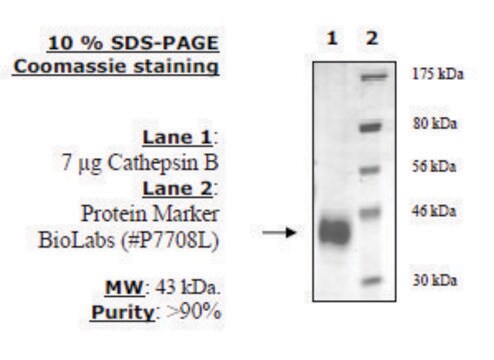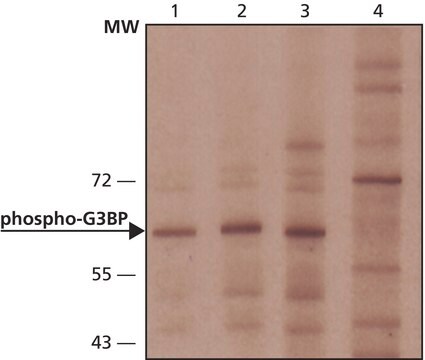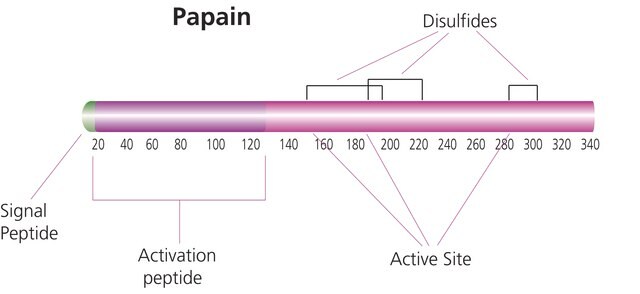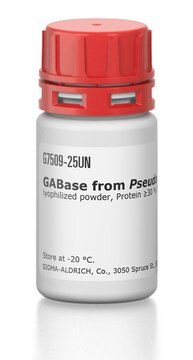C4249
Cystatin B human
recombinant, expressed in E. coli
Synonym(s):
CPI-B, CST6, CSTB, EPM1, Liver Thiol Proteinase Inhibitor, PME, STFB, Stefin B
Sign Into View Organizational & Contract Pricing
All Photos(1)
About This Item
UNSPSC Code:
12352202
NACRES:
NA.77
Recommended Products
recombinant
expressed in E. coli
Quality Level
description
contains a N-terminal 7X His-tag
Assay
≥95% (SDS-PAGE)
form
solid
mol wt
apparent mol wt ~13 kDa by SDS-PAGE (reducing)
NCBI accession no.
storage temp.
−20°C
Gene Information
human ... CSTB(1476)
General description
Cystatin B is a member of the type 1 (stefins) superfamily of cystatins. Cystatin B is encoded by the CSTB gene and functions as an intracellular thiol protease inhibitor regulating the activity of members of the papain family and cathepsins B, H, and L. Cystatin B may also protect cellular components from the effects of proteases that leak from lysosomes. Mutations in the CSTB gene are thought to be the primary defect in patients with Progressive Myoclonus Epilepsy (EPM1).
Application
Suitable for use as a cysteine-protease inhibitor. Is tested for suitability as an inhibitor of the enzymatic activity of papain.
Biochem/physiol Actions
Cystatin B was shown to interact with the protein RACK-1, β-spectrin and neurofilament light chain NF-L forming a unique multiprotein complex specifically in the cerebellum, confirming its function in the brain.
Reconstitution
Cystatin B should be reconstituted at 100 μg/mL in steile 25 mM Tris pH 7.5 and 100 mM NaCl. Reconstituted product should be stored in single-use aliquots at -70° C and should be stable for at least 3 months.
Storage Class Code
11 - Combustible Solids
WGK
WGK 3
Flash Point(F)
Not applicable
Flash Point(C)
Not applicable
Certificates of Analysis (COA)
Search for Certificates of Analysis (COA) by entering the products Lot/Batch Number. Lot and Batch Numbers can be found on a product’s label following the words ‘Lot’ or ‘Batch’.
Already Own This Product?
Find documentation for the products that you have recently purchased in the Document Library.
Rossella Di Giaimo et al.
Human molecular genetics, 11(23), 2941-2950 (2002-10-24)
Cystatin B is an anti-proteolytic polypeptide implicated in progressive myoclonus epilepsy (EPM1), a degenerative disease of the central nervous system. The knock-out mouse model of the disease shows apoptosis of the cerebellar granule cells. We have identified five recombinant proteins
Hana Dvořáková et al.
Frontiers in cellular and infection microbiology, 10, 66-66 (2020-03-17)
Schistosomula (the post-infective stages) of the neurotropic schistosome Trichobilharzia regenti possess multiple isoforms of cathepsin B1 peptidase (TrCB1.1-TrCB1.6) with involvement in nutrient digestion. The comparison of substrate preferences of TrCB1.1 and TrCB1.4 showed that TrCB1.4 had a very narrow substrate
Amanda Phuong Tran et al.
The Journal of neuroscience : the official journal of the Society for Neuroscience, 38(23), 5399-5414 (2018-05-16)
Severed axon tips reform growth cones following spinal cord injury that fail to regenerate, in part, because they become embedded within an inhibitory extracellular matrix. Chondroitin sulfate proteoglycans (CSPGs) are the major axon inhibitory matrix component that is increased within
Vincenzo Lionetti et al.
PloS one, 10(7), e0133810-e0133810 (2015-07-24)
Pectin is secreted in a highly methylesterified form and partially de-methylesterified in the cell wall by pectin methylesterases (PMEs). PME activity is expressed during plant growth, development and stress responses. PME activity is controlled at the post-transcriptional level by proteins
Our team of scientists has experience in all areas of research including Life Science, Material Science, Chemical Synthesis, Chromatography, Analytical and many others.
Contact Technical Service





